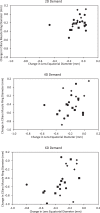Quantification of age-related and per diopter accommodative changes of the lens and ciliary muscle in the emmetropic human eye
- PMID: 23287789
- PMCID: PMC3567753
- DOI: 10.1167/iovs.12-10619
Quantification of age-related and per diopter accommodative changes of the lens and ciliary muscle in the emmetropic human eye
Abstract
Purpose: To calculate age-related and per diopter (D) accommodative changes in crystalline lens and ciliary muscle dimensions in vivo in a single cohort of emmetropic human adults ages 30 to 50 years.
Methods: The right eyes of 26 emmetropic adults were examined using ultrasonography, phakometry, anterior segment optical coherence tomography, and high resolution magnetic resonance imaging. Accommodation was measured both subjectively and objectively.
Results: In agreement with previous research, older age was linearly correlated with a thicker lens, steeper anterior lens curvature, shallower anterior chamber, and lower lens equivalent refractive index (all P < 0.01). Age was not related to ciliary muscle ring diameter (CMRD) or lens equatorial diameter (LED). With accommodation, lens thickness increased (+0.064 mm/D, P < 0.001), LED decreased (-0.075 mm/D, P < 0.001), CMRD decreased (-0.105 mm/D, P < 0.001), and the ciliary muscle thickened anteriorly (+0.013 to +0.026 mm/D, P < 0.001) and thinned posteriorly (-0.011 to -0.015, P < 0.01). The changes per diopter of accommodation in LED, CMRD, and ciliary muscle thickness were not related to subject age.
Conclusions: The per diopter ciliary muscle contraction is age independent, even as total accommodative amplitude declines. Quantifying normal biometric dimensions of the accommodative structures and changes with age and accommodative effort will further the development of new IOLs designed to harness ciliary muscle forces.
Conflict of interest statement
Disclosure:
Figures







Comment in
-
Image registration required for magnetic resonance imaging experiments of accommodation.Invest Ophthalmol Vis Sci. 2013 Mar 13;54(3):1857-8. doi: 10.1167/iovs.13-11784. Invest Ophthalmol Vis Sci. 2013. PMID: 23485633 No abstract available.
Similar articles
-
Simultaneous measurements of refraction and A-scan biometry during accommodation in humans.Optom Vis Sci. 2006 Sep;83(9):657-65. doi: 10.1097/01.opx.0000232810.61191.02. Optom Vis Sci. 2006. PMID: 16971844
-
Age-related changes in the anterior segment biometry during accommodation.Invest Ophthalmol Vis Sci. 2015 Jun;56(6):3522-30. doi: 10.1167/iovs.15-16825. Invest Ophthalmol Vis Sci. 2015. PMID: 26030106 Free PMC article.
-
Non-invasive measurements of the dynamic changes in the ciliary muscle, crystalline lens morphology, and anterior chamber during accommodation with a high-resolution OCT.Graefes Arch Clin Exp Ophthalmol. 2017 Jul;255(7):1385-1394. doi: 10.1007/s00417-017-3663-4. Epub 2017 Apr 20. Graefes Arch Clin Exp Ophthalmol. 2017. PMID: 28424868
-
Accommodating intraocular lenses: a critical review of present and future concepts.Graefes Arch Clin Exp Ophthalmol. 2007 Apr;245(4):473-89. doi: 10.1007/s00417-006-0391-6. Epub 2006 Aug 30. Graefes Arch Clin Exp Ophthalmol. 2007. PMID: 16944188 Review.
-
[Deterioration of amplitude of the accommodation with age and its possible restoration in the intraocular lens implanted eye].Nippon Ganka Gakkai Zasshi. 1992 Sep;96(9):1071-8. Nippon Ganka Gakkai Zasshi. 1992. PMID: 1414696 Review. Japanese.
Cited by
-
Pharmacological Treatment of Presbyopia by Novel Binocularly Instilled Eye Drops: A Pilot Study.Ophthalmol Ther. 2016 Jun;5(1):63-73. doi: 10.1007/s40123-016-0050-x. Epub 2016 May 11. Ophthalmol Ther. 2016. PMID: 27168149 Free PMC article.
-
The Predictability of Preoperative Pilocarpine-Induced Lens Shift on the Outcomes of Accommodating Intraocular Lenses Implanted in Senile Cataract Patients.J Ophthalmol. 2016;2016:6127130. doi: 10.1155/2016/6127130. Epub 2016 Jul 19. J Ophthalmol. 2016. PMID: 27516899 Free PMC article.
-
In vivo measurement of the human crystalline lens equivalent refractive index using extended-depth OCT.Biomed Opt Express. 2019 Jan 4;10(2):411-422. doi: 10.1364/BOE.10.000411. eCollection 2019 Feb 1. Biomed Opt Express. 2019. PMID: 30800489 Free PMC article.
-
An analytical method for predicting the geometrical and optical properties of the human lens under accommodation.Biomed Opt Express. 2014 Apr 28;5(5):1649-63. doi: 10.1364/BOE.5.001649. eCollection 2014 May 1. Biomed Opt Express. 2014. PMID: 24877022 Free PMC article.
-
Improving children's visual health by integrating motor imagery training into physical education classes.Front Psychol. 2025 Jun 9;16:1587481. doi: 10.3389/fpsyg.2025.1587481. eCollection 2025. Front Psychol. 2025. PMID: 40552201 Free PMC article.
References
-
- Atchison DA. Accommodation and presbyopia. Ophthalmic Physiol Opt. 1995; 15: 255–272 - PubMed
-
- Murphy SL, Xu JQ, Kochanek KD. Deaths: preliminary data for 2010. Natl Vital Stat Rep. 2012; 60: 30
-
- National Institute on Aging Growing Older in America: The Health and Retirement Study. National Institutes of Health, U.S. Department of Health and Human Services. 2007. Available at: http://www.nia.nih.gov/health/publication/growing-older-america-health-a.... Accessed January 17, 2013
-
- Moschis G, Lee E, Mathur A, Strautman J. The Maturing Marketplace: Buying Habits of Baby Boomers and Their Parents. Westport, CT: Quorum Books; 2000.
-
- Richdale K, Mitchell GL, Zadnik K. Comparison of multifocal and monovision soft contact lens corrections in patients with low-astigmatic presbyopia. Optom Vis Sci. 2006; 83: 266–273 - PubMed
Publication types
MeSH terms
Grants and funding
LinkOut - more resources
Full Text Sources
Other Literature Sources
Medical

